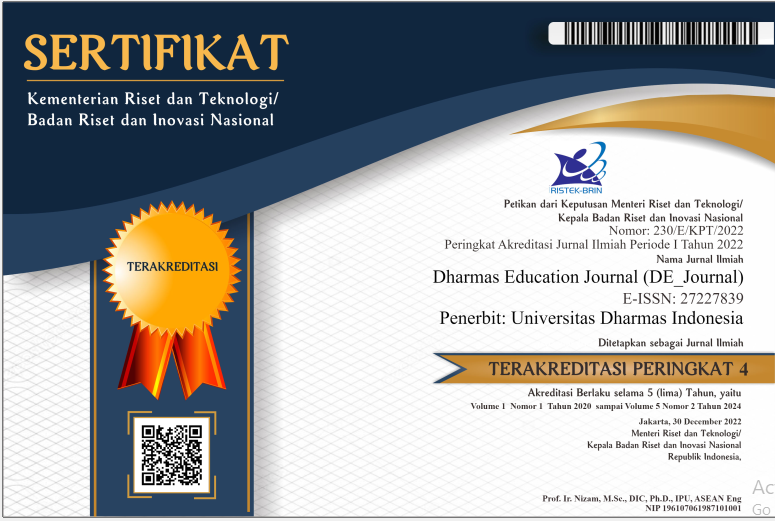STRATEGI SEKOLAH DALAM PENINGKATAN PESERTA DIDIK BARU (STUDI KASUS SMA LABSCHOOL UNESA 1)
DOI:
https://doi.org/10.56667/dejournal.v4i1.952Keywords:
School Strategy, New Students, Case StudyAbstract
The emergence of private schools in urban areas is to fill the lack of availability of public schools because the population is not balanced with the number of schools. The mushrooming of private schools raises new problems in getting students in uncertain conditions. Many private schools do not get students or do not fit the class, which makes these private schools have to be closed. SMA Lab School UNESA 1 has a strategy used to increase the number of students in each new school year. The purpose of this research is to see how the school's efforts to increase the number of students in the new school year. In this study using a qualitative case study method, data collection techniques were used by interviews, observation, and documentation studies. The subjects in this study were the school principal, vice principal, teacher, and student guardians. Data analysis techniques with data condensation, data presentation, and data conclusions are displayed. The results of this research have three main themes, namely the school's internal strategy in improving the school's internal system, external strategies related to cooperative relations and communication carried out by school stakeholders, and the obstacles experienced can be used as a reference for future evaluations in improving school strategies. The conclusion of the strategy carried out by SMA Lab School is to improve the internal quality of the school, improve cooperative relations with externals, and pay attention to the obstacles that occur during the process of implementing the strategy in increasing the number of students in the new school year.
Downloads
References
Abbott-Chapman, J., Johnston, R., & Jetson, T. (2022). Rural Parents’ School Choices: Affective, Instrumental and Structural Influences. Australian and International Journal of Rural Education, 27(3), 126–141. https://doi.org/10.47381/aijre.v27i3.142
Arikunto, S. (2019). Prosedur Penelitian. Jakarta. Rineka Cipta.
Azzahra, N. F. (2020). Ringkasan Kebijakan | Mengkaji Hambatan Pembelajaran Jarak Jauh di Indonesia di Masa Covid-19. CIPS Indonesia, 19(2), 1–9.
Baker, B. D. (2012). Charter Schools Are … [ Public ? Private ? Neither ? Both ?]. 1–6.
Buchari. (2016). Manajemen Pemasaran dan Pemasaran Jasa. Alfabeta. Alfabeta.
Davis, T. (2013). Charter School Competition, Organization, and Achievement in Traditional Public Schools. Education Policy Analysis Archives, 21, 1–25. http://epaa.asu.edu/ojs/article/view/1044
Fattah, N. (2012). Ekonomi dan Pembiayaan Pendidikan. PT. Remaja Rosdakarya Offset.
Fuad, M., & Nurhattati. (2016). Manajemen Sarana dan Prasarana Pendidikan: Konsep dan Aplikasinya. PT Rajagrafindo.
Humaida, N., Aula Sa’adah, M., Huriyah, H., & Hasanatun Nida, N. (2020). Pembangunan Berkelanjutan Berwawasan Lingkungan (Sustainable Development Goals) Dalam Perspektif Islam. Khazanah: Jurnal Studi Islam Dan Humaniora, 18(1), 131. https://doi.org/10.18592/khazanah.v18i1.3483
Jones, J.J. & Walters, D. L. (2008). Human resource management in education. QMedia.
Jubelina, J., & Supramono, S. (2013). Strategi Bersaing Sekolah Kristen Lentera Ambarawa. Satya Widya, 29(2), 73. https://doi.org/10.24246/j.sw.2013.v29.i2.p73-82
Lubis, A. (2004). Strategi Pemasaran dalam Persaingan Basnis. Fakultas Ekonomi Manajemen.
Marit, D. (2021). PENGANTAR ILMU EKONOMI (A. Karim (Ed.)). Yayasan Kita Menulis.
Miles, M.B, Huberman, A.M, & Saldana, J. (2014). Qualitative Data Analysis, A Methods Sourcebook (T. Rohindi Rohidi (Ed.)). Sage Publication.
Muhaimin, S., & Listyo Prabowo, S. (2012). Manajemen Pendidikan: Aplikasinya dalam Penyusunan Rencana Pengembangan Sekolah/Madrasah. Prenada Media Group.
Purwanto, N. A. (2015). Strategi Bersaing Dalam Bisnis Pendidikan. Jurnal Manajemen Pendidikan UNY, 01, 113658. https://www.neliti.com/publications/113658/
Rusman. (2009). Manajemen Kurikulum (2nd ed.). Rajawali Press.
Shobri, M., & Ansharuddin, M. (2022). Pelatihan Membuat dan Mengelola Website Madrasah se-KKMA dan KKMTs Sangkapura. DEDICATE: Journal of Community Engagement in Education, 1(1), 28–37.
Subakat Tatwa, G. (2021). Peran Public Relations Dalam Pengoptimalan Penggunaan Media Digital di Masa Pandemi. 84–92.
Uno, H. B., & Nina Lamatenggo. (2016). Tugas guru dalam pembelajaran : aspek yang mempengaruhi/ Hamzah B. Uno, Nina Lamatenggo. 197.
Wallo, A., Martin, J., Sparrhoff, G., & Kock, H. (2022). Balancing “Critique for Improvement” With “Critique for Emancipation” in Management Learning and Education. Journal of Management Education, 46(3), 506–530. https://doi.org/10.1177/10525629211044720
Wayong, M. (2017). MENUJU ERA GLOBALISASI PENDIDIKAN: Tantangan dan Harapan bagi Perguruan Tinggi di Tanah Air. Inspiratif Pendidikan, 6(2), 219. https://doi.org/10.24252/ip.v6i2.5223
Downloads
Published
How to Cite
Issue
Section
License
Copyright (c) 2023 Dharmas Education Journal (DE_Journal)

This work is licensed under a Creative Commons Attribution-NonCommercial-NoDerivatives 4.0 International License.
Makalah yang disampaikan diasumsikan tidak mengandung bahan propietary yang tidak dilindungi oleh hak paten














